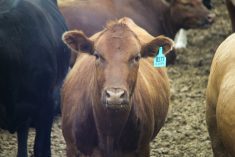When feed is tight and times are tough, early calf weaning is an option — albeit an unusual one, says one of the country’s leading cattle experts.
“Early weaning is talked about a lot, but not many people do it,” said Dr. John Campbell, a professor of large-animal clinical sciences at the Western College of Veterinary Medicine and an expert in beef animal health and welfare.
“It’s sort of an exceptional circumstance for the situation.”
But if this turns out to be another drought year, he suspects more producers will try early weaning.
Campbell said he has read a lot of literature about it, but doesn’t have a lot of real-life experience.
“We traditionally wean calves at six to eight months of age,” he said. “I guess when we have limited feed resources, early weaning can be considered an advantageous strategy.”
Those who wean early tend to do it when calves are three to five months of age. The practice lowers overall forage consumption (because a lactating cow needs to eat a lot) while also helping to maintain the mother cow’s body condition.
“It will improve the reproduction the next year for the cows because the cows are coming through the winter in better body condition as well,” said Campbell.
Body condition is an issue in many herds this spring because feed was in such short supply this winter and that forced many producers to improvise.
“People have had to rely on a lot of weird and wonderful feeding strategies this winter, so we’re seeing a lot of cows in less than optimal body condition this year,” said Campbell. “Probably, we’ll end up seeing poor reproduction next fall when we do preg checking because a bunch of those cows just aren’t going to cycle like they normally would, or as early as they normally would if they came in with a better body condition score.
“That’s sort of the trickle-down effect.”
Cows that are not lactating do eat less — about 76 per cent of the forage compared to one still nursing her calf.
“You increase your carrying capacity by 25 per cent if you wean those cows early. That’s the big advantage,” he said.
What about the calves?
There are two options, said Campbell.
One is to sell them but that means finding a market that will pay a relatively high price for lightweight calves. Some feedlots will buy lighter animals, but the price may not be very attractive.
“That’s not uncommon to see, but the economics of the pricing of those animals, that may play a role in whether or not you can afford to market your calves, or whether you can feed them yourself,” said Campbell.
That second option — backgrounding them yourself — not only requires feed resources (which may continue to be in short supply) but also facilities (pens to hold and separate the calves), as well as some level of expertise.
“That’s the biggest issue with early weaning,” said Campbell. “There’s no doubt that it has a benefit for the (mother) cows, but what is your strategy for dealing with the calves at an earlier age?”
Early-weaned calves are usually good at gaining weight even if forage conditions aren’t optimal for the dam.
“You get more efficient feed use — those early-weaned calves are pretty feed efficient when they are young, so that’s an advantage and you can carry more cows,” said Campbell.
But the calves are also at a higher risk of contracting respiratory disease.
“You have to have pretty good management and calf nutrition if you are going to retain those calves yourselves,” he said. “It’s a challenging thing and I think that’s why we don’t see if very often. Those challenges keep people from doing it, even though there are obvious benefits to the cows.”
Campbell said last fall would have been the time for early weaning, but if it’s another drought year, some people might consider trying it this year.
“We might see more of it,” he said. “To me, it’s always about the logistics of having feed and facilities for the calves, and having a market for them. That’s the biggest challenge with doing it and what makes it most challenging for most producers.”
A lot of producers don’t have extra holding areas or capacity for calves because they sell calves directly to the market. (A 2015 study found 70 per cent of producers do abrupt weaning, which involves taking the calf off the cow and selling it right away.)
Even if you plan to stick with your regular weaning practice, remember that both feed issues and the cold weather this winter have taken their toll, Campbell added.
“Vitamin A is a major issue if they (cattle) haven’t been supplemented well,” he said. “There wasn’t a lot of green forage for the grazing season and now through the winter, so there’s vitamin A deficiency.
“We’re seeing some weird and wonderful metabolic things because we’re feeding a lot of greenfeed or… unusual winter feeds that might not have been used in other years. That can create potential problems.”
















